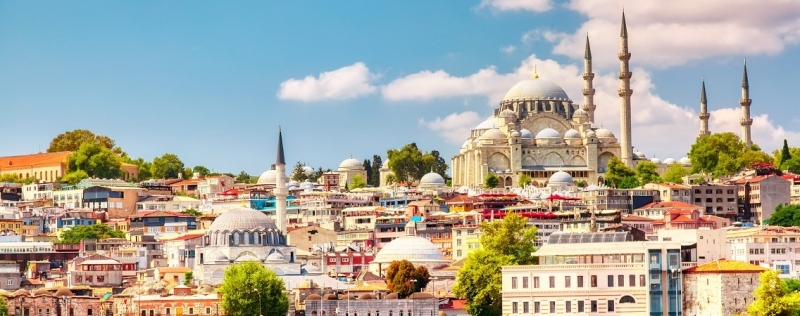
Constantinople, the city of seals, the legacy of the Byzantine Empire, the most European city in Turkey – all this is about him. Thousands of articles have been written about Istanbul, but if you are visiting for the first time, we recommend checking out our guide. In it we collected the main attractions, and also told where to stay, what to try, what cafes and restaurants to visit and what to take home as souvenirs.
How to get there
To enter Istanbul you will only need a foreign passport. Russians can stay in the country for 60 days. All COVID-19 restrictions have been lifted in Turkey.
There are regular direct flights from Russia to Istanbul. Ticket prices from Moscow start from 9,000 rubles* one way.
Planes arrive at one of two airports, Istanbul Havalimani (IST) and Sabiha Gökçen (SAW). Both are approximately 40 km from Istanbul. You can get to the city by bus or taxi. If you choose a taxi, we recommend downloading the Uber or BiTaxi apps in advance, the trip will be more profitable with them.
Where to stay
Istanbul has many accommodation options to suit every taste and budget. We have selected three hotels with good locations and ratings from OneTwoTrip guests.
Small hotel House MOLA Galata (rating 9.1) – located in the Karakoy area. Cost of a night in a room for two from 5,100 rubles*.
The four-star Hotel Yigitalp Istanbul (rating 8.5) is a hotel in the very center, breakfast is included in the price. Cost of a night in a room for two from 12,000 rubles*.
DoubleTree by Hilton Istanbul — Sirkeci (rating 8.3) is a four-star hotel of a famous global chain, located 2.4 km from the center of Istanbul. Cost of a night in a room for two from 15,600 rubles*.
When to go
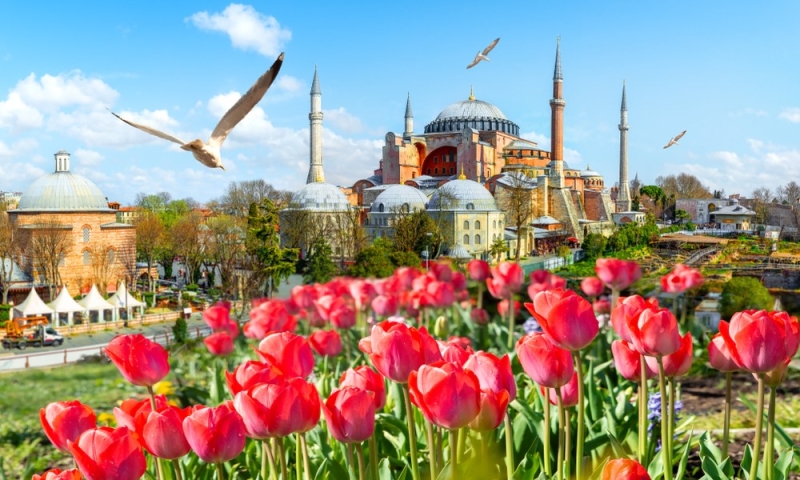
The ideal time to travel to Istanbul is considered to be the off-season: the periods from April to May and from September to November. At this time, the region has the most comfortable weather for walking, and housing prices are lower than in summer – this season, despite the heat, is considered high.
Winters in the city are cool and dank. The temperature almost never drops below zero during the day, on average it stays around +3…+9 °C, but cold winds blow from the bay. In addition, in winter there are often long rains, and sometimes sleet falls. However, many people go to Istanbul to see the sights at this time of year because there are fewer tourists during the low season.
Warmth comes to Istanbul in mid-March, and in April the city turns green and blossoms. In addition, this month there is a large-scale and colorful tulip festival.
The period from June to early September is considered the high tourist season. In July and August, the average temperature is +28 °C, but feels higher due to high humidity. But this time is perfect if you want to explore the beaches of Istanbul and the surrounding area – the water in the Black and Marmara seas is warmed up to +25 °C.
Istanbul residents themselves consider September to be the best month to visit the city (we would also add the beginning of October). The air temperature drops to comfortable levels, and it is very pleasant to walk, and there is still little rain – it begins in mid-October. In November, the city will appeal to those who want to explore museums and other attractions: the weather is already deteriorating, but it is still suitable for walking (up to +20 °C during the day), and prices are already seriously lower than in summer, and there are noticeably fewer tourists.
What to see in Istanbul
There are so many important and iconic places in the former Constantinople that it is simply impossible to cover them all in one article. We have selected the top attractions in Istanbul, which you can explore in a few days if you wish. But we advise you not to limit yourself to this list and set aside at least a week for your trip – this way you can get the most complete impression of the city. And you will almost certainly come back here again.
Blue Mosque
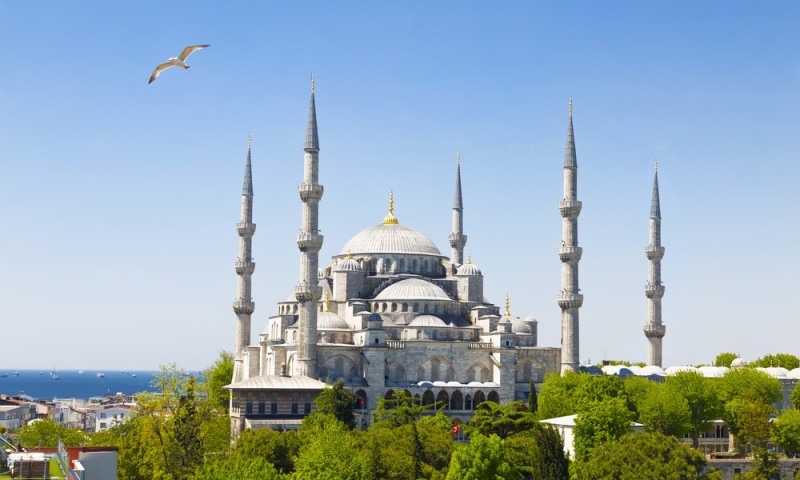
If you want to see the main attractions of Istanbul, start exploring the city from Sultanahmet Square. On it you will immediately notice the famous Blue Mosque – the most significant in the city (and there are about three thousand of them here). It differs from others not only in size, but also in the large number of minarets – there are six of them, whereas usually only four are erected.
The mosque is so called due to the blue majolica that covers the walls almost completely. In general, its real name is Sultanahmet (Sultan Ahmed Mosque), or Ahmediye. Ahmed I went down in the history of Turkey as one of the kindest rulers, and built the majestic mosque to appease Allah – at the beginning of his reign, due to his youth, he made many mistakes that cost the country its authority in the world.
The Blue Mosque is operational, but tourists are not allowed there. The main thing is to choose the time between prayers and maintain respect for faith and traditions (do not make noise, choose clothes that cover the body, take off your shoes when entering). The most convenient time to visit the mosque is from 8:30 to 11:30, from 13:00 to 14:30 and from 15:30 to 16:45. At this time, you will almost certainly not disturb anyone. On Fridays, the mosque holds a large namaz (prayer), so it will be very crowded inside in the morning – plan your visit for the afternoon.
Hagia Sophia
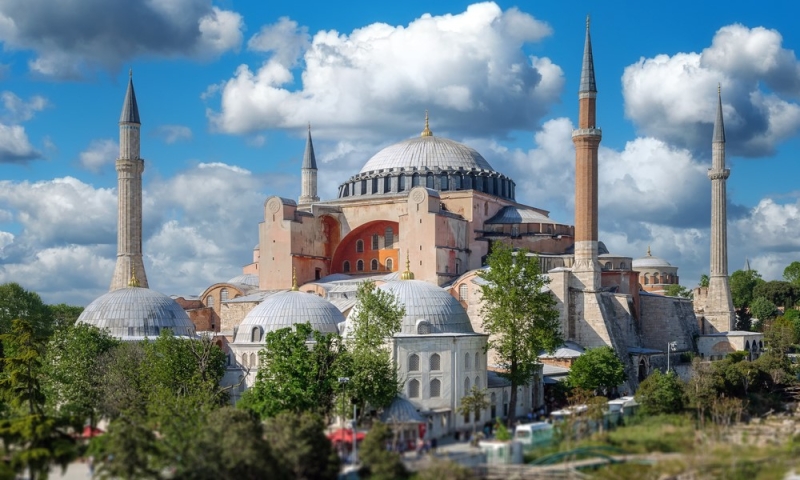
Another main attraction of Istanbul, the famous Hagia Sophia is located on Sultanahmet Square directly opposite the Blue Mosque. This cathedral is a monument of Byzantine architecture; it was erected in the 6th century by order of Emperor Justinian. When Constantinople, as Istanbul was then called, was conquered by Mehmet the Conqueror in 1453, the new ruler was so struck by the beauty of the temple that he ordered it to be converted into a mosque. So minarets appeared around the cathedral, and the domes were crowned with crescents.
In the 20th century, Hagia Sophia was a museum, but in 2020 it again became a mosque – now prayers are held inside, but tourists are still allowed in. Come any time except prayer hours. It is important for women to cover their heads and exposed parts of the body with a scarf.
Grand Bazaar
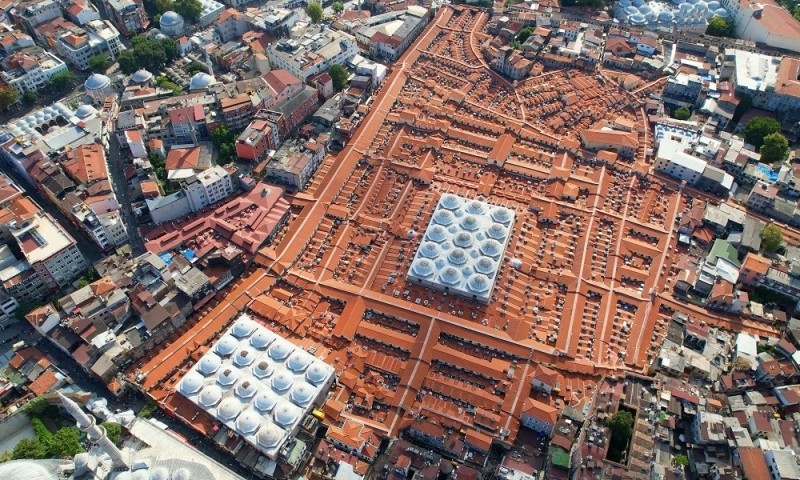
This bazaar is truly grandiose – it is considered one of the largest covered markets in the world. It is located a kilometer from Sultanahmet Square, so you can walk there. A visit to the Grand Bazaar is an obligatory part of the cultural program: nowhere else in Istanbul will you see such a variety of goods and feel such an atmosphere. Plus, this is probably number one on the list of “Free things to do in Istanbul” (although only entry is free – we’re sure you won’t leave without shopping).
In fact, this is not one market, but several blocks under a roof. Inside there are 61 streets, more than four thousand shops, there are even mosques, a school and a bathhouse. Every day the bazaar, or Kapaly Charshi, as the locals call it, is visited by more than five hundred thousand people.
The assortment of goods is dizzying: they sell ceramics, silver, gold, costume jewelry, scarves, carpets, figurines, spices, tea… You can not only bargain, but you have to, because the initial price is usually too high. But even if you don’t plan to buy anything, it’s definitely worth going under the arches of the bazaar, built in the 15th century – to admire the architecture and get inspired by the local spirit. In addition, it is pleasant and cool here even in the summer heat.
The Grand Bazaar is open every day, except Sundays and religious holidays. Opening hours from 8:30 to 19:00.
Topkapi Palace
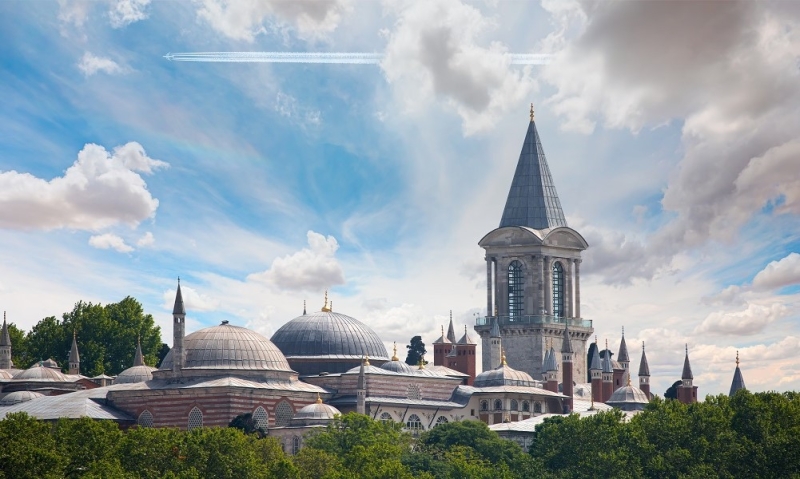
From Sultanahmet Square you can walk to the luxurious main palace of the Ottoman Empire. It remained the residence of Turkish rulers until the 19th century, and was built already in 1479, and on the site of an even more ancient palace of Byzantine rulers. The complex of buildings stands on the shores of the Sea of Marmara and is clearly visible from the water – beautiful photos can be taken during a boat ride along the Bosphorus.
The name “Topkapi” translates as “cannon gate” and was not chosen by chance: the fact is that every time the Sultan left the residence, a cannon shot was heard.
The palace complex consists of four separate courtyards with a total area of seven hundred thousand square meters. Once upon a time, a huge number of people worked here – they say there were a thousand servants in the kitchen alone. The territory also housed a treasury, an armory, stables, a garden and terraces with fountains.
Today Topkapi is a museum where you can look at the treasures of the sultans and various relics. Tourists are usually very interested in the harem – the chambers of wives and concubines and their personal belongings. The museum is open from 9:00 to 19:00 in summer (closes at 16:00 in winter). Closed on Tuesdays.
Galata Tower
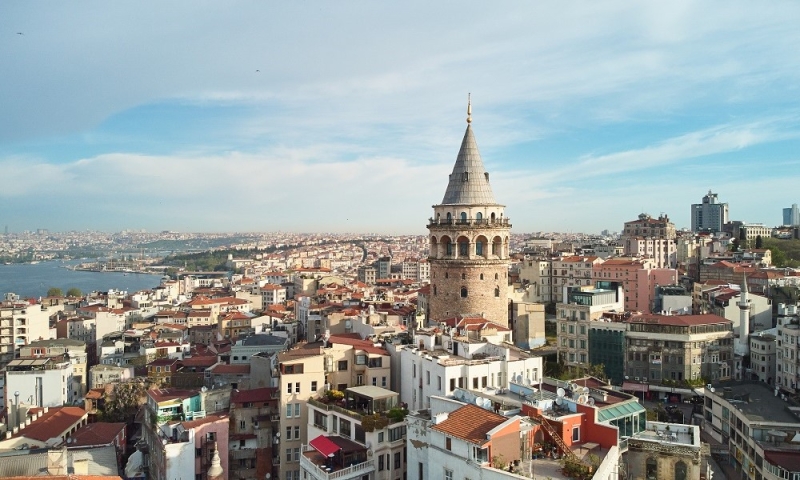
This beautiful building was erected in 1348 to monitor ships appearing in the Bosphorus, as well as to monitor fires. For many years, the 61-meter-high tower remained the tallest building in Constantinople. In addition, it is located on a hill and therefore visible from almost anywhere in Istanbul.
Today there is an observation deck at the top of the tower, which offers a wonderful view of the city. There is no need to climb on foot: there are two elevators inside. Upstairs you can have a snack in a cafe or have a full lunch in a restaurant.
The Galata Tower is open daily from 8:30 to 20:00. We recommend coming here in the late afternoon to watch the sunset from above. Admission is paid, the ticket costs 100 liras.
Dolmabahce Palace
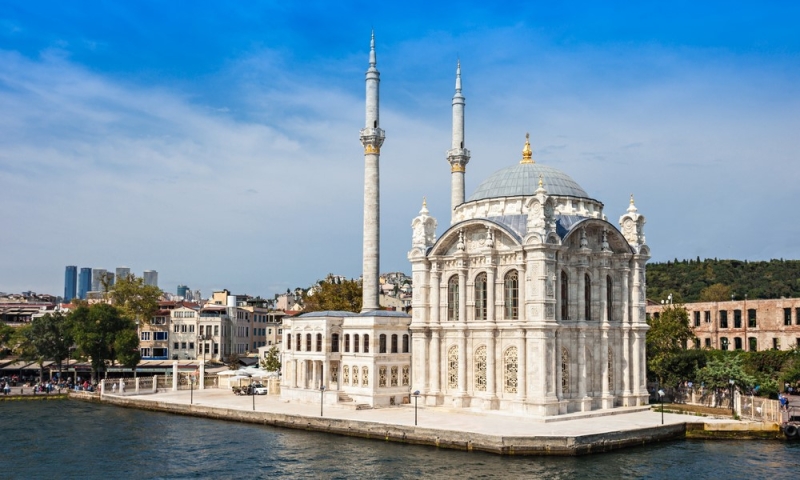
This beautiful building is usually noticed by tourists during excursions along the Bosphorus: the impressive Baroque façade looks out over the water. The building was built from 1842 to 1853 by order of Sultan Abdulmecid I. The ruler did not want to live in Topkapi Palace, and he built a new residence for himself in the image of European palaces. After the fall of the monarchy, the first president of Turkey, Mustafa Kemal Ataturk, lived here.
Since 1984, the building has housed a museum. During the tour you can see the premises, including the luxurious ceremony hall, the harem and Atatürk’s room. There is also a mosque on site and several themed museums, such as clocks and paintings.
The palace is open to the public every day except Mondays from 9:00 to 18:00, but some pavilions close at 17:00. Entrance ticket costs 300 liras.
Maiden Tower
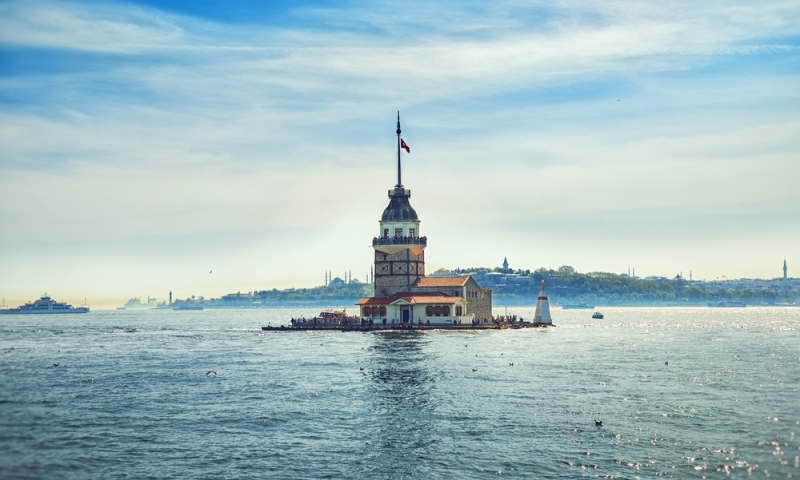
One of the most recognizable landmarks of Istanbul. The tower is located on a small island in the Bosphorus, in the Asian part of the city. It is the only surviving Byzantine monument in the area.
Tourists are attracted by the legends associated with this building. Over its long history – the tower was built in the 4th century under Emperor Constantine – it has been a lighthouse, a customs point, a lookout point and even a restaurant. She can be seen in the film “The World Is Not Enough” about agent 007 and in Aivazovsky’s painting “View of the Leander Tower in Constantinople.”
Why Leandrova? It is believed that it was here that an ancient Greek youth named Leander sailed every evening to meet his beloved Hero, the priestess of Aphrodite. The girl lit a lantern at the top so that her beloved would not go astray. One day the fire went out, and Leander drowned – and after him, the inconsolable Hero threw herself into the water.
Today there is an observation deck and a nice restaurant in the tower. You can get to the island by ferry, which departs from the Salacak pier every 15 minutes from 12:00 to midnight. The cost of travel and visiting the tower is 40 liras.
Beaches
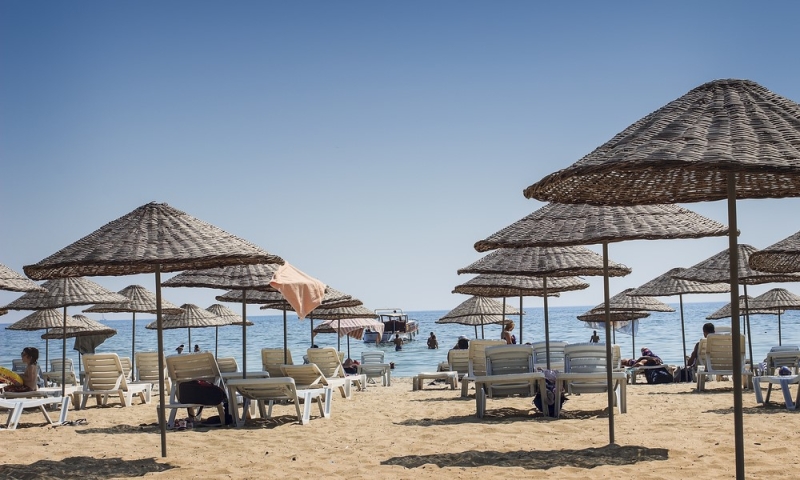
Istanbul is washed by two seas, the Black and the Marmara. In summer, the water here warms up to +25 °C, and it seems logical to go to the beach. However, Turkey’s city beaches are not clean and can often be unsafe to swim there, although they are crowded in the heat. Locals go to Kyuchuksu or Jaddebostan (there are three holiday locations).
We recommend choosing one of the private beaches in the northern part of the city – it is cleaner and less crowded. For example, Uzunya Beach is considered one of the most beautiful places to relax in Istanbul. The entrance ticket will cost 15 liras on weekdays and 25 on weekends. Another good option is Suma Beach, where guests are also offered free Wi-Fi. Young people often hang out here. A ticket on weekdays also costs 15 liras, on weekends it is twice as expensive.
5 things you should definitely do in Istanbul
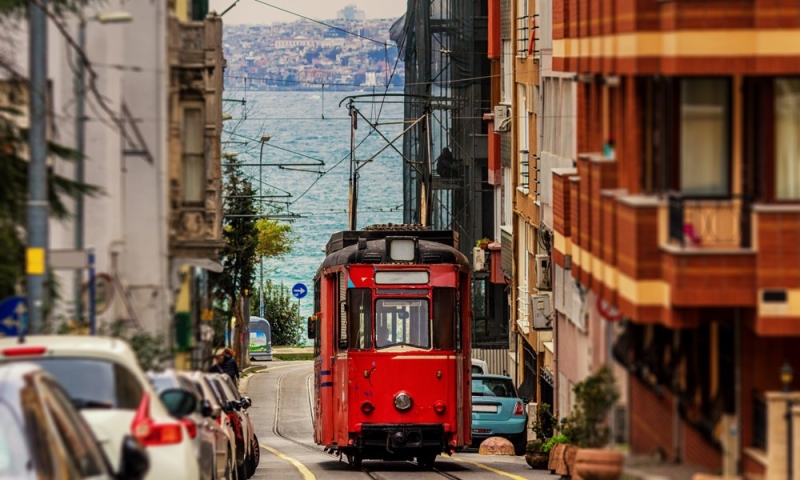
Take a ride along the Bosphorus and feed the seagulls on board a boat or ship. In addition, from the water you will see a slightly different Istanbul, and during a 5-6 hour cruise you will be able to see all the main mosques and palaces.
Visit the Sultan’s Hammam. Some local baths have seen a lot in their lifetime. The most famous Istanbul hammams are Cemberlitas (built in 1584) and Ayasofya Hurrem Sultan (in 1557).
Try dondurma. This local sweet is made from milk, sugar and salep (sweet flour made from orchis tubers). It turns out something similar to ice cream, only more viscous and thick, so dondurma is often eaten with a knife and fork.
Ride the red tram along Istiklal Avenue. This is one of the most popular and crowded streets in Istanbul, and the famous red retro tram that slowly travels along the avenue appears on many postcards and souvenirs. It starts from Taksim Square and runs every 10 minutes. The fare is the same as for regular public transport, but be prepared to stand in line to get on the tram.
Go shopping in the Kadikoy area. Here you can buy almost everything: there are popular chain stores with world brands, colorful bazaars, small shops, and even flea markets and antique shops. In general, you can buy some clothes and look for unusual souvenirs.
What to see in the area
We recommend taking some time to explore the sights near Istanbul. Here you can find many beautiful natural locations, cute towns and parks.
Prince’s Islands (Adalar)
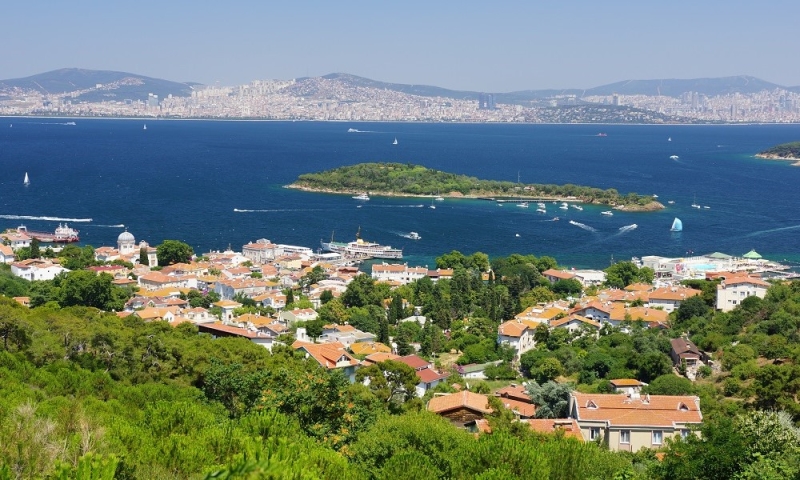
This place is usually the first thing people remember – and no wonder. There are nine beautiful islands in the Sea of Marmara, although only four of them are inhabited. People usually come here for a day to spend time on the beach or have a picnic. There are many beautiful ancient buildings on the islands, and you won’t find ordinary cars or other motorized transport here—locals care about the environment and travel by bicycles, electric cars, or horse-drawn carts.
The most popular islands are Buyukada (the largest and most visited) and Heybeliada (the greenest). Burgazada and Kynalyada are also accessible to tourists.
How to get there: by ferry. They depart from Kabataş pier on the European side of the city and from Kadıköy and Bostancı on the Asian side. In summer there are 15 ferries per day. Swim for at least one hour.
Belgrad Forest (Belgrad Ormanı)
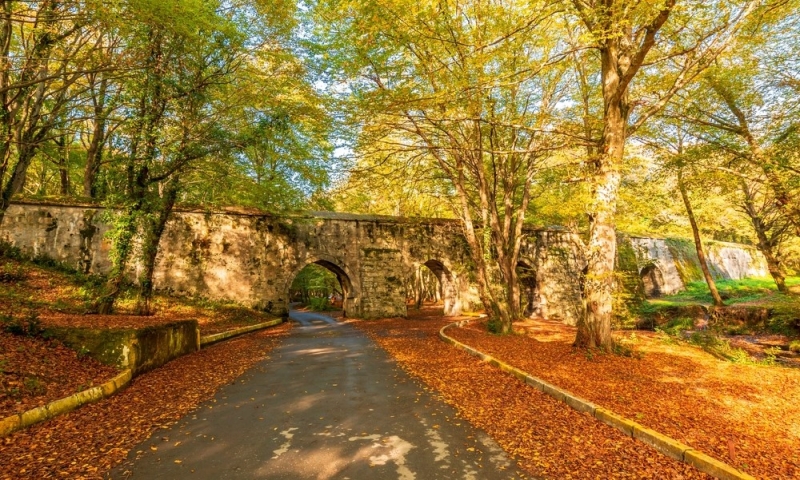
The surroundings of Istanbul are rich in attractions, one way or another connected with nature. Belgrade Forest is a large forest park just 20 km from Istanbul. Mostly oaks grow here, but there are also chestnuts and even birches. Citizens come here to take a break from the hustle and bustle of the metropolis. You can have a snack in one of the cafes or take food with you – there are picnic areas in the park. There are also playgrounds and an equestrian center. And of course, it’s nice to just walk along the paths, listen to birdsong and admire the ancient aqueducts.
You can also visit the Ataturk Arboretum next to the reservoir – more than 2,000 species of plants are collected on the territory.
How to get there: the most convenient way is by car, but you can also get there by bus (42T from Taksim Square or 42 and 42M from metro station 4. Levent).
Anadolu Kavağı
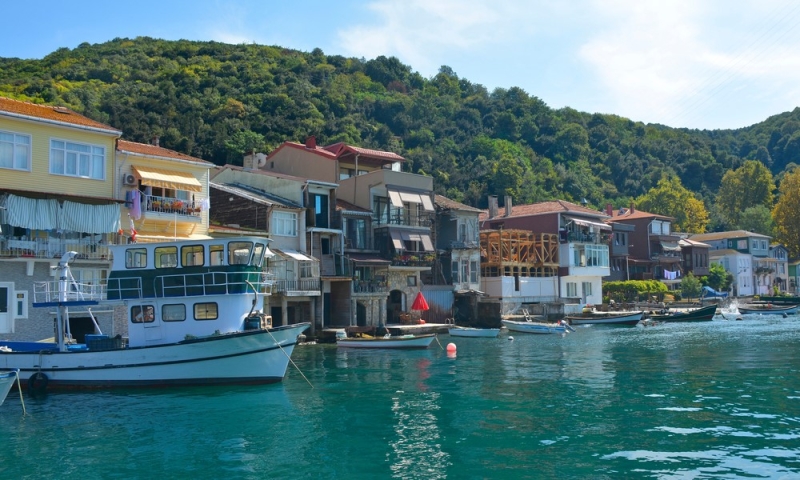
A small fishing town, which is technically located in the Beykoz district of Istanbul. It’s worth coming here to admire the green hills, colorful wooden houses with a view and boats moored at the pier. Walk along the beach, dine on the freshest fish at any local cafe and climb to the ruins of the Yoros Fortress – the main attraction of the city. From the height you will have a stunning view of the confluence of the Bosphorus and the Black Sea.
How to get there: usually stop here during a big tour of the Bosphorus. There is also the option to travel on your own by ferry from the Sarıyer pier.
Şile
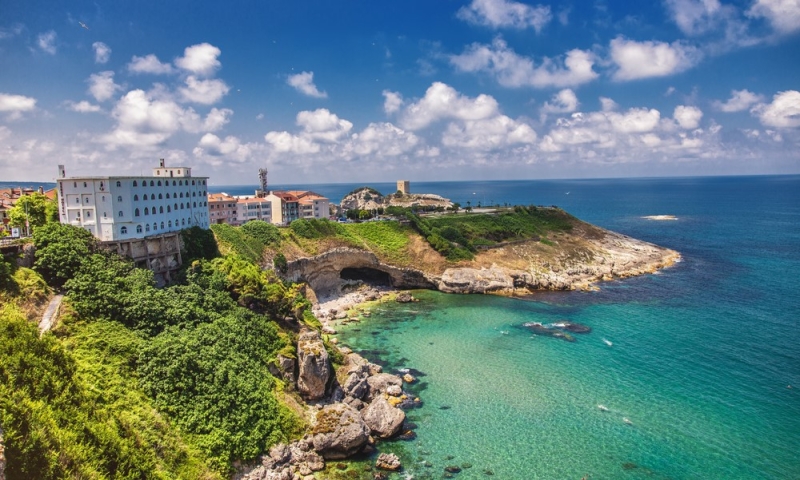
A small resort 60 km from Istanbul, on the Black Sea coast. Istanbul residents themselves often relax here. The village is very beautiful: an unusual coastline with rocks, and among the attractions are a fortress, forts and towers of different periods and an active lighthouse, inside of which there is a museum.
There are also very good restaurants with fresh seafood. There are also beaches, but you shouldn’t swim – there are dangerous currents off the coast that can carry you out to the open sea. So focus on visiting the antiquities, having lunch and walking along the sea.
How to get there: by buses 139 and 139A (depart from the stop at the Üsküdar pier).
Restaurants and cafes
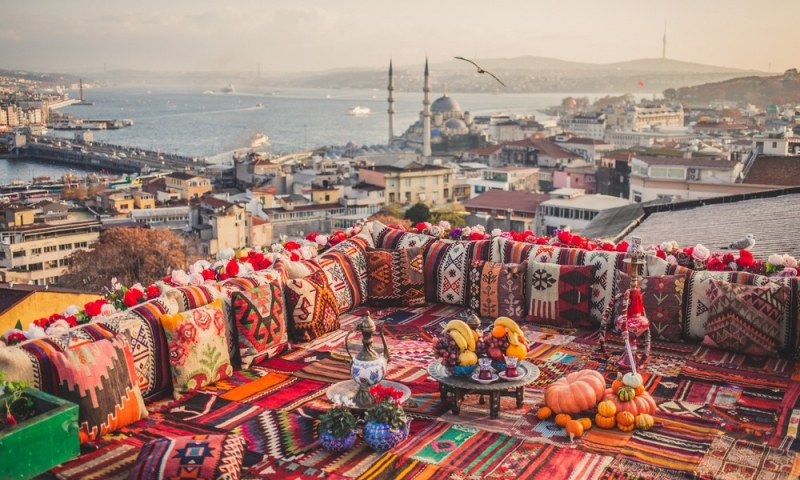
Turkish cuisine is very rich in meat: they eat kebabs and kofte (small fried cutlets), and the kings of local street food, which are definitely worth trying, are considered to be doner and durum (analogous to the usual shawarma), pide (an open flatbread with meat) and lahmacun (also a flatbread). with meat, but thinner and a little similar in appearance to pizza). Also in Istanbul, we recommend ordering fish and seafood in a restaurant, and trying balyk durum on the street (like shawarma, but fish is wrapped in pita bread with pomegranate sauce and vegetables). Among the dishes that do not contain meat and fish, simits (bagels with sesame seeds) are popular. And for dessert – Turkish coffee with real honey baklava.
Gulhane Sark Sofrası (AlayKosku Cad. No: 22). Large selection of Turkish cuisine, fresh fish, sweets and hookah. Guests highly praise the friendly staff.
By Ferro Fish & Kebab House (Emin Sinan mahallesi No 85, Kadırga Limanı Cd., 34130 Fatih/İs 85A). As the name suggests, the establishment specializes in fish dishes and kebabs. Located in the historical center of the city, you can stop by for lunch after sightseeing.
Seven Hills Balikcisi (Cankurtaran Mahallesi, Tevkifhane Sokak No: 8, Kat:3). Famous rooftop restaurant in Sultanahmet. It is worth coming here for lunch or dinner with a beautiful view of the Bosphorus and the city center. You can also feed the seagulls here.
Dukkan Galata (Mueyyedzade Mah. Tatar Beyi Sokak 15/B Galata Beyoğlu 15B). A modern place, stylish and cozy, but you won’t find Turkish meat dishes here. But you can have a great breakfast with avocado toast and red fish and drink a latte.
Aşşk Kahve (Muallim Naci Cad. Kuruçeşme Mahallesi No 64). A cafe with authentic Turkish breakfasts, and in a cool location overlooking the Bosphorus. You can sit in the green garden or at a table by the water. Breakfast is assembled like a construction set.
Karaköy Güllüoğlu(Rıhtım Cad. Katlı Otopark Altı No: 3-4). They say they sell the best baklava in Istanbul, so we recommend stopping by to check it out. The sweets are fresh, they are baked every morning. If you wish, you can buy something to take with you as souvenirs, then the baklava will be sealed in a tight vacuum bag so that it reaches the recipient in the best possible condition.
What to bring
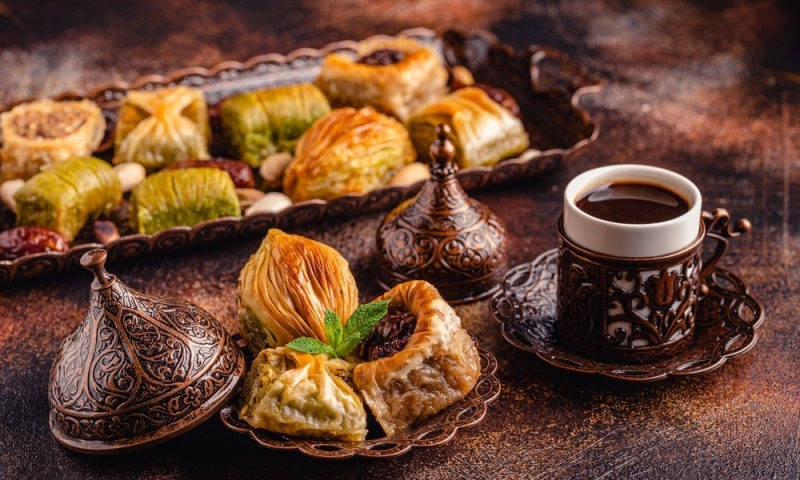
Real black tea and accessories for its preparation – a two-tier chaydanlyk teapot (the principle of operation is a bit like a samovar) and a couple of armuds (cute glasses, in which the drink is served). When choosing tea, give preference to options without any additives – they are often chemical and are designed for tourists. The Turks themselves drink only regular black tea.
Coffee and authentic Turkish coffee. We advise you to buy local brand Mehmet Efendi coffee in the company store. Ask them to grind the beans in front of you in a huge coffee grinder. And to brew real Turkish coffee at home, buy a Turk, or cezve. The best vessels are made of copper, and thanks to this metal, the ground coffee is evenly heated and imparts its aroma and taste to the drink.
Turkish sweets – for coffee or tea. Choose what you like best: soft and sticky Turkish delight, honey baklava (baklava) or crumbly halva. You can also try sujuk, sherbet, nougat, revani or kadaif.
Spices. At the market you can choose by weight both the usual mint, cinnamon or cloves, as well as local rare species. For example, isot (a very hot red pepper), sumac (a burgundy-colored spice that gives the dish a slightly sour taste and citrus aroma) or baharat (a universal seasoning that contains about twenty types of spices, including black pepper).
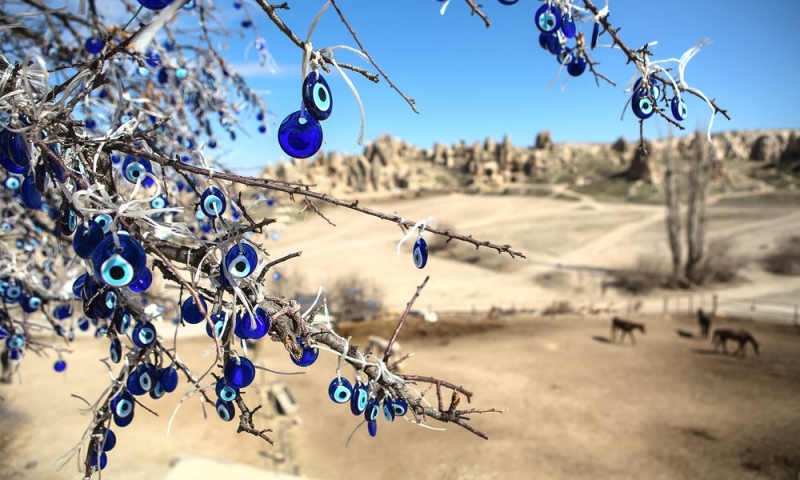
Nazar bonjuk amulet (eye of Fatima). This round blue disk, on which a pattern in the shape of an eye is applied, is very popular in Turkey and in the East in general. It is believed that it protects against the evil eye, envy and evil thoughts. In Istanbul, you will find many souvenirs featuring this eye, from tiny beads and small keychains to large pendants that can be placed at the entrance to your home.
Cat figurine. Istanbul can be called a cat city – here you can see these cute pets at almost every step. Turks generally consider cats to be sacred animals; they are even allowed to be inside mosques (unlike dogs). In souvenir shops you will find dozens of different figurines, both very simple and decorated with traditional patterns and beads.
Conclusion
We hope you found our article useful, in which we collected the attractions of Istanbul with prices and visiting hours, and also told you how to get to this Turkish city and where to stay there. And you can always find tickets and hotels at competitive prices on OneTwoTrip.
When planning a trip, make your hotel reservations in advance. OneTwoTrip offers more than two million accommodation properties worldwide.
*Prices are current at the time of publication.

